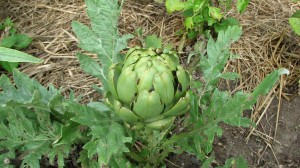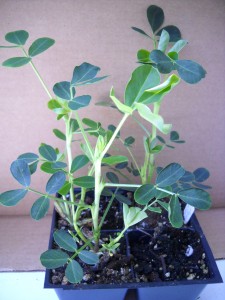Artichokes, Carrots and Beets, Oh My!
I think I have grown, at one time or another, every kind of vegetable one can grow in New England, from artichokes to zucchini. Some, like carrots and beets, are worthy of a spot every year. Others, like fall radishes and spinach, get missed some years. One of the most interesting, but least productive, is the artichoke.
I’ve been to Castroville, California, which claims to be the artichoke capital of the world. Hundreds of acres of artichokes line the highway. They are perennials there, huge plants spaced 5 feet apart and producing many fat artichokes on each plant. Not so here. Artichokes don’t survive the winter for me, even well mulched. And they take a long time to start from seed – I start them in February on years when I grow them. Fortunately, some good garden centers sell started plants, so one does not have to run grow-lights for 4 months to get a garden-grown artichoke. Edgewater Farm in Plainfield, NH sells them.
 An artichoke plant will produce, for me, one medium sized artichoke and perhaps 3 smaller ones as side shoots. It takes a space two feet square and needs rich, moist soil. Some years I’ll get my first artichoke in August, but one year it only started producing after the first frost scared it a bit. I harvested it after Halloween, having built a little greenhouse over it.
An artichoke plant will produce, for me, one medium sized artichoke and perhaps 3 smaller ones as side shoots. It takes a space two feet square and needs rich, moist soil. Some years I’ll get my first artichoke in August, but one year it only started producing after the first frost scared it a bit. I harvested it after Halloween, having built a little greenhouse over it.
Consider the lowly carrot. For a dollar or so, you can buy a pound of them. Crisp, orange, tasty. When I was growing up in the 1950’s, my Irish cousin Richard was occasionally called “carrot top” because he had bright orange hair. Carrots only came in orange, back in the early 1950’s. Not so now. It’s worth planting some, and the time is now. But you may want to try some new varieties – they now come in purple, yellow and white.
There are 3 key steps involved in getting good big carrots: 1) prepare the soil so that it is loose and deep – a foot deep or more. No stones, and plenty of compost. 2) Thin them out. Carrot seeds are tiny, and often end up planted too close together. Get them an inch apart as soon as you can. 3) Give them a little organic fertilizer in early July. Just sprinkle lightly alongside the row, and scratch it in a bit. July Fourth is a good day to fertilize them – you probably won’t have work that day.
Beets are good not only as a root crop, but also for the tops, which are tasty when steamed up and served with butter. No matter how carefully you space your beets, they will still need to be thinned out. Why is that? Because those big fat “seeds” you planted are not seeds at all, but seed capsules. Like an apple, each contains more than one seed. Actually, ‘Moneta’ is a variety with only one seed per capsule, sold by Johnny’s Seeds.You can leave clusters of beets for a few weeks after germination so that when you thin them the plants are of a size worth cooking.
Your peas, if you planted them in April, should be up by now. Peas, even the short-vined varieties, do best with some support to keep them from flopping on the ground. Chicken wire is the standard, but if you have a pile of trimmings left from pruning your apple trees, you can use small branches to support your peas. Just push them into the soil.
Those apple branches can be used in other ways, too. If you have cats, you know that they love to dig in soft soil and leave you presents. Place apple branches over newly worked beds to keep cats out. You might even be able to keep deer away from your tulips now, by poking bigger branches in the tulip bed to physically keep them back. I haven’t done so because Daphne, my corgi, seems to keep the deer away with her scent.
We will have another frost this spring, I assume, but that won’t affect my lettuce, onions, spinach or root crops. I try to plant lettuce every 3 weeks or so all summer to keep a steady supply. My first lettuces are up and looking good, so now I will plant another batch. I like to plant lettuces 6 to 9 inches apart in order to get nice full heads of lettuce. Sometimes I start a cluster of seeds all in one place, not bothering to space them out. Then, when the leaves are 1 to 2-inches tall, I gently tease the plants apart and re-plant with wide spacing. I like to plant red and green varieties and alternate them in the row for the looks of it.
I said above that I’ve tried every kind of vegetable from A to Z, but I haven’t. This year, for the first time, I am going to grow peanuts! I got seeds from Burpee’s Seeds, and have some growing indoors under lights. I will also plant some directly in the soil when the soil temperature is above 60 degrees. I’ll report back to you later. And please keep me informed if you grow something special and wonderful. We’re in this gardening game together.
Henry’s Web site is www.Gardening-Guy.com. You may e-mail him at henry.homeyer@comcast.net.



